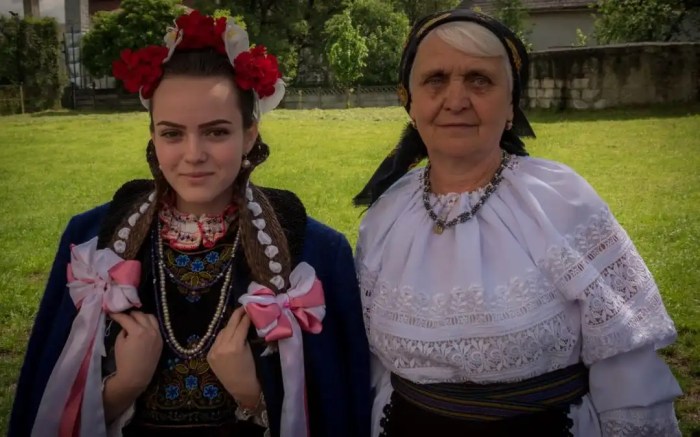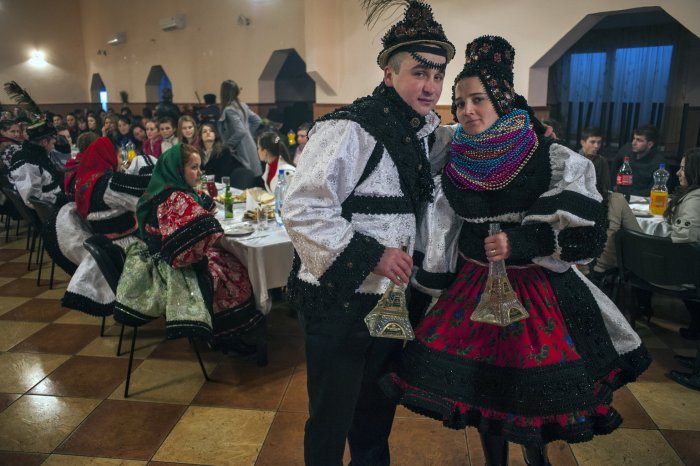Traditional Gypsy Wedding Dresses A Rich History
A Historical Journey Through the Gypsy Wedding Dress: Traditional Gypsy Wedding Dress
The traditional Gypsy wedding dress, a vibrant tapestry woven from centuries of tradition and cultural exchange, is more than just attire; it’s a living testament to a nomadic heritage. Its evolution reflects the diverse journeys and influences experienced by Roma communities across the globe. This exploration delves into the historical development, symbolic elements, and modern reinterpretations of this captivating garment.
Historical Evolution of the Gypsy Wedding Dress
The evolution of the Gypsy wedding dress is a complex narrative, varying significantly across different Roma communities and geographical locations. While pinpointing precise dates is challenging due to the oral tradition and nomadic lifestyle, discernible stylistic changes and influences can be traced through time. Early dresses, likely influenced by the regions where Roma communities settled, often featured simpler designs using readily available materials.
Over time, as trade routes expanded and interactions with other cultures increased, more elaborate embellishments and fabrics were incorporated. For example, the influence of local peasant clothing styles in certain regions is evident in earlier iterations. The introduction of new fabrics and embroidery techniques further enriched the design, creating regional variations that are still visible today.
Key Design Elements and Symbolism

Source: true-romania.tours
Traditional Gypsy wedding dresses are known for their vibrant colors and intricate embroidery, often featuring rich reds and golds. A modern interpretation might draw inspiration from the flowing silhouettes, incorporating a beautiful gradient effect, much like the stunning hues found in a sunset ombre wedding dress. This transition offers a contemporary twist on the classic, maintaining the spirit of bold color and romantic flair inherent in the traditional design.
The overall effect remains celebratory and visually striking.
Several key design elements consistently define traditional Gypsy wedding dresses, each imbued with symbolic meaning. These elements are not uniform across all Roma communities but reflect shared cultural values and beliefs. Common features include vibrant colors, intricate embroidery, and lavish embellishments. The color red, for example, often symbolizes passion, fertility, and good luck. Elaborate embroidery patterns, often passed down through generations, tell stories and carry family history.
The choice of fabrics, such as silk, velvet, or brocade, reflects the family’s economic standing and demonstrates a commitment to creating a stunning and enduring garment.
The Role of Color and Fabric
Color and fabric selection in Gypsy wedding dresses are far from arbitrary; they hold deep cultural significance. Red, as mentioned, is prevalent, signifying joy, vitality, and protection. Other colors, such as gold, represent wealth and prosperity, while black can symbolize mourning or, conversely, the mystery and depth of life. The fabrics themselves also convey meaning; luxurious silks and velvets indicate affluence, while more modest materials reflect simpler circumstances.
The use of specific fabrics and colors can vary across different Gypsy communities, adding another layer of complexity to the sartorial tradition.
| Tradition | Color | Symbolism | Description |
|---|---|---|---|
| Romani (Spain) | Red | Passion, fertility, good luck | Often used as the dominant color, representing celebration and vitality. |
| Vlax Romani (Romania) | Gold | Wealth, prosperity, status | Used in embroidery and embellishments to symbolize the family’s prosperity. |
| Kalo Romani (Greece) | Black | Mystery, depth, resilience | Can be used in accents or as a background color, representing the enduring nature of Romani culture. |
Embroidery and Adornments
Intricate embroidery and embellishments are hallmarks of traditional Gypsy wedding dresses. These adornments are not merely decorative; they tell stories, convey cultural identity, and often reflect family history. Techniques vary from region to region, ranging from delicate chain stitch to bold appliqué work. Motifs frequently incorporate floral designs, geometric patterns, and symbolic imagery. The craftsmanship involved is often a testament to generations of passed-down skills and artistic traditions.
- Floral motifs: Represent growth, fertility, and beauty.
- Geometric patterns: Symbolize order, structure, and protection.
- Symbolic imagery: Can include religious or mythological elements specific to the region.
- Appliqué: Layering fabric pieces to create intricate designs.
- Beadwork: Adding sparkle and opulence.
Modern Interpretations of the Traditional Dress, Traditional gypsy wedding dress

Source: theblacksea.eu
Contemporary designers are increasingly drawing inspiration from traditional Gypsy wedding dresses, incorporating their vibrant colors, intricate embellishments, and symbolic motifs into modern designs. This reinterpretation involves a delicate balance between honoring tradition and creating contemporary aesthetics. Challenges include adapting traditional techniques to modern manufacturing processes and ensuring that the designs remain respectful and authentic.
| Designer | Dress Element | Traditional Interpretation | Modern Adaptation |
|---|---|---|---|
| [Designer Name – Example] | Embroidery | Intricate floral patterns | Simplified floral motifs, incorporated into a flowing silhouette |
| [Designer Name – Example] | Color Palette | Rich reds and golds | Muted tones of red and gold, combined with neutrals |
Illustrative Examples of Traditional Gypsy Wedding Dresses
The diversity of Gypsy communities is reflected in the wide range of traditional wedding dresses. Three examples highlight this variation.
Example 1: A Spanish Romani Dress: Imagine a vibrant red dress, possibly made of silk or velvet, heavily embellished with gold embroidery. The embroidery features intricate floral motifs, symbolic of fertility and prosperity. The overall silhouette is typically flowing and full, creating a dramatic and celebratory look. The texture is rich and luxurious, emphasizing the celebratory nature of the occasion.
Example 2: A Vlax Romani Dress (Romania): This dress might be characterized by its use of darker colors, perhaps deep blues or greens, accented with gold threads. The embroidery might feature geometric patterns, reflecting the community’s strong emphasis on tradition and structure. The overall effect is one of elegant sophistication, balanced with a strong sense of cultural heritage. The fabrics would likely be more durable, reflecting the practicality of the nomadic lifestyle.
Example 3: A Kalo Romani Dress (Greece): This dress could incorporate black as a dominant color, perhaps with accents of red or gold. The embroidery might feature more stylized floral patterns or even symbolic imagery. The silhouette might be simpler, focusing on clean lines and elegant draping. The overall aesthetic would be one of understated elegance, with a focus on the quality of the materials and craftsmanship.
Query Resolution
What materials are traditionally used in Gypsy wedding dresses?
Traditional Gypsy wedding dresses often incorporate luxurious fabrics like silk, velvet, and brocade, reflecting the value placed on rich materials within the culture.
What is the significance of specific embroidery patterns?
Embroidery patterns often hold deep symbolic meaning, varying across different Gypsy communities. Some patterns might represent good luck, fertility, or protection, passed down through generations.
Are there regional differences in Gypsy wedding dress styles?
Yes, significant regional variations exist. Dresses from Spain might differ significantly in style, color, and embellishment from those found in Eastern European communities, reflecting the diverse nature of Gypsy culture.
Where can I find authentic Gypsy wedding dresses or inspired designs?
Finding authentic traditional dresses can be challenging. However, some designers specialize in creating modern interpretations that incorporate traditional elements. Online searches and specialized boutiques might offer options.



















